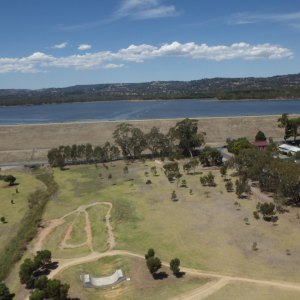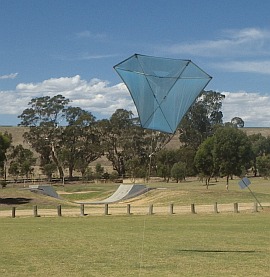- Home Page
- Aerial Photos
- Happy Valley Reservoir
Happy Valley Reservoir (2)
KAP Report
 Happy Valley Reservoir
Happy Valley Reservoir
Recently, I made another attempt to get good KAP (kite aerial photography) photos of the Happy Valley Reservoir from the park on its western side.
Not a dog owner was in sight this time—good! Nothing against them, but people walking and playing with dogs simply does not mix well with doing KAP.
Circumstances on the day dictated doing the flying between 1 pm and 3 pm. This was a risk in the warm sunny conditions due to the inevitable rough air up there. So the ever-reliable Multi-Dowel Barn Door kite was selected. It has never let me down in light-to-moderate winds!
Last time, only the flight which took video got high enough to see the water. So stills had to be taken from video. There was no such problem on this session, though, despite having to wait for a lengthy gust to get the kite up.
On this site, there's more kite-making info than you can poke a stick at. :-) Want to know the most convenient way of using it all?
The Big MBK E-book Bundle is a collection of downloads—printable PDF files which provide step-by-step instructions for many kites large and small.
That's every kite in every MBK series.
Weather
The panoramic photo below shows a small section of the pale-brown west embankment of the reservoir—just like last time, except from a slightly different viewpoint. Play "spot Tim's white Lantra" in the enlarged version. The car does its best to sneak into various KAP panoramas or even aerial shots from time to time!
Overall, the weather this time was remarkably similar to last time. As before, a line of cumulus clouds stretched right up and down the Adelaide Hills, some of which you can see in the panorama. The sky was almost blue over most of Adelaide.
Winds were light but not as light as last time. With every thermal lifting off or passing through, a worrying amount of leaf noise would be generated in the nearby tall gum trees. Would it overpower the kite?
Once again, doing all the setting up of line, rig, and kite was sweaty work. The temperature turned out to be just below 35 degrees Celsius at the time.
Equipment
 MBK Multi-Dowel Barn Door
MBK Multi-Dowel Barn DoorLifter: The 2.4 meter (8 foot) span Multi-Dowel Barn Door kite. I plain forgot to attach drogues to steady the kite's motion. But with launching so marginal today, it was perhaps for the better. Even so, the kite descended right to the grass before I could ready the camera for its second sequence of shots.
See my e-book Making Dowel Kites for more big but cheap kite-designs useful for KAP.
KAP Rig: Bamboo-skewer cradle, suspended from a half-Picavet line. The camera was pointed downwind, with the direction adjusted between flights to capture the entire reservoir. Perhaps other wind directions would allow just two photos to capture the entire extent of the water.
Camera: Pentax Optio WG-2 with built-in intervalometer. For the aerial shots, EV was set to -0.7 and focus was fixed on infinity. Auto ISO ended up on 125–200 with a shutter speed of 1/1,500.
Images
Click on the thumbnail images below to see them much larger:
Flight Report
Three panoramic photos were taken with the aid of the little yellow chair that is marked with the appropriate angles. The camera stitches three photos into one. The best panorama appears near the top of this page.
After laying down about 60 meters (200 feet) of line, I walked out with
the camera, the bamboo cradle, and the Multi-Dowel Barn Door kite.
The first job was to check the camera's settings and insert it into the bamboo cradle. Next, the two sides of the half-Picavet suspension were unwound and attached to the flying line. Finally, the big barn-door kite was rigged and launched without much trouble in the next hefty gust.
With the camera suspended right in front of me, a small tweak ensured that it was pointing in roughly the right direction. Then it was time to carefully walk back to the kite's anchor point, letting the flying line slip through my hand and under my arm. This worked OK, since the average wind-speed was quite light. If everything tightened up, I just slowed down a bit.
During the walk back, the kite hung fairly low. At one point, it was necessary to stop completely to allow some gain of height.
Back
at the anchor point, it didn't take long for the kite to smoothly gain
height until it was hovering around 40 degrees or so most of the time. That was a
bit low, but it was right near the bottom of its wind range and
carrying the KAP rig on the line. A patch of rising air helped the kite
up much higher as evidenced by some of the resulting photos.
It looked like the camera had been pointing slightly to the south, so on bringing the rig back in, I tweaked the moveable bamboo cradle about 20 degrees anticlockwise for the next sequence of shots. With a four-minute delay before the first photo went off, there was just a little pressure to relaunch the kite quickly. The kite had descended all the way to the grass while I wasn't looking!
This time I had used a steel
carabiner to slip along the flying line and bring the KAP rig down. So
now it was a matter of reversing the procedure. I walked back with a
finger holding one end of the shiny steel loop and the flying line
slipping through the other.
Toward the end of this second flight, things got interesting, with a massive thermal forming right over the field! I could even see the cloud starting to form, several thousand feet above. The big blue barn-door got sucked right up to vertical and pulled the line tight while it was there. The hapless KAP rig swung every which way, doing a spot of KAP pole-dancing around the line.
After a couple of anxious minutes and a couple of vertical dives downwind from overhead, the big kite steadied, and the whole setup returned to normal—as if nothing had happened. Whew.
KAP is often something of an adventure. But I think the photos were much better this time.
The story or stories above document actual flying experiences. My write-ups are definitely "warts and all," since things don't always go totally as planned. However, half the fun of kiting is anticipating the perfect flight. When it happens, it's magic!
As mentioned earlier, there's more kite-making info here than you can poke a stick at. :-)
Want to know the most convenient way of using it all?
The Big MBK E-book Bundle is a collection of downloads—printable PDF files which provide step-by-step instructions for many kites large and small.
That's every kite in every MBK series.





